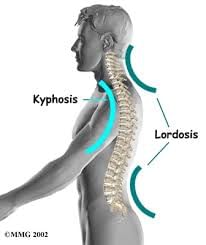Cervical Lordosis Straightening Treatment
Most commonly known as a military neck a straight or forward curve of the neck is abnormal and may cause an unkind progression of symptoms leading ultimately to cervical disk degeneration.
Reversal of cervical lordosis explained
The anatomy of the neck features a lordotic curvature in its typical and healthy state. This means that the cervical region has a gentle curvature with the open end of that curve facing the rear of the body. The base and top of the curve will be further posterior than the mid point, which will be further anterior.
When the lordosis is straightened, the neck becomes more upright and linear. This is more common than the next progression of atypical curvature, which is the subject of this article.
Actual reversal of curvature means that part or all of the cervical spine develops a kyphotic profile, with the open end of the curve facing anteriorly. Usually, this reversal is extremely mild, but is still very abnormal. What we now see is the middle of the curve being positioned posterior to the top and bottom.
In essence, picture the letter c and now turn it backwards: This is the shape of a reversed cervical lordosis.
Reversal of cervical lordosis causes
The spinal curvature in the neck is constantly in flux to some degree.
Congenital conditions and developmental conditions can have lasting effects on the natural degree of curvature typically demonstrated from patient to patient. These circumstances may be explainable due to injury or degeneration, or may be idiopathic:
Scoliosis can affect the normal lordotic curvature in the neck.
Cervical spondylolisthesis is a major source of reversed lordotic curvature.
Severe disc pathologies can facilitate a gradual loss or reversal of cervical lordosis.
Vertebral irregularities, such as wedging, can definitely contribute to lordotic alteration.
Traumatic injury, including vertebral fracture, can create the ideal circumstances for a reversal of lordosis to take place.
Severe neck muscle spasms can actually reshape the spinal curves, although these are usually temporary expressions and not actual structural conditions.
Effects of reversal of cervical lordosis
The neck is designed to curve in order to balance the spine, absorb stress, distribute force and provide proper movement of the head. When this curvature is diminished or reversed, symptoms may result, although this is not an inherent part of any altered lordotic condition.
Patients may experience stiffness and tension in the neck. Pain may be present and may even be severe in rare cases. Neurological dysfunction is possible in extreme cases, since the neuroforamen might not align properly, thereby causing a cervical pinched nerve.
In the worst circumstances, central spinal stenosis in the neck might affect the viability of the spinal cord, possible enacting the most dire of symptoms throughout the body.
Patients will also be more prone to injury, since the normal shock absorption qualities of the typical curvature have been lost.
While all these effects are certainly possible, they are not usual. In fact, a great majority of patients have minor symptoms or even no symptoms at all from mild reversed lordotic curvatures.
The pathology leading to a neck curve reversal (cervical kyphosis shown below right) may be inspired by a multitude of conditions as follows:
Post whiplash
Post head injury
Stomach sleeping
Poor sitting/working postures
Congenital spinal curvatures
Osteoporosis
Degenerative cervical discs (a form of osteoarthritis that can either be the cause of or the result of a cervical kyphosis)
Compression fracture of vertebral body
Infection of the cervical spine
Anatomy: straight vs. Curved
I've always heard that it was good to stand up straight.
stand upright, stick your chest out and hold your shoulders back! otherwise you're going get widows hump.
Are these expressions as familiar to you as they are to me? one might think that having a curved neck goes against what we heard from parents and teachers as we were growing up, but the reality is that there is a little bit a truth in both. Maintaining good posture throughout our lives is crucial to both the health of our spine and vital organs. On the contrary, a special type of curve called a lordosis is a good thing, both in the neck and lower back.
When we look at a person from the back their spine should be truly straight, so that the left and right sides of one's body is symmetrical. However, when we view a person from the side, the front and back of their body is different and this is reflected in a coinciding curvature of the spine. Both the lower back and neck are hollowed out (concave) and the mid or thoracic spine is protrudes (convex). Thus there is an alternation of curves functioning to provide stability, shock absorption and aid in propulsion. A straight spine would be very stiff and not flexible. Imagine the plight of a pole vaulter with an inflexible pole.
Nature's design of our spine and rib cage facilitates breathing and offers protective and supportive framework for vital organs. Spinal disks are shock absorbers and because they are in the front of the spine, lordotic curvatures keep them from having to bear weight. Kyphosis or loss of such curvatures bears weight upon the disks, leading to their ultimate degeneration. This process of deterioration is a form of osteoarthritis and in the spine is known as degenerative spondylosis.
Diagnosis
Although most physiotherapists or conservative orthopedists can recognize a cervical curve reversal upon viewing the patient's posture, a definitive diagnosis may be obtained via a standing lateral (side view) x-ray of the neck. Cause can often be determined by corroborating a comprehensive history, a thorough examination, x-rays and questions about sleep, work and lifestyle.
In my professional career I found that the majority of young adults presenting with cervical kyphosis either had a whiplash or were stomach sleepers from an early age. For desk jockeys 40-60 years of age, many hours of sitting with their head flexed forward almost dictates the fate of developing kyphosis. In prior years I considered cervical kyphosis a job hazard for the careers of accountants, attorneys and often teachers because of years spent with their head in a book or paperwork. However, the digital age offers some relief in that respect. A well-planned, ergonomically-friendly office can do wonders for protecting the spine in the sedentary worker.
Treatment for cervical curve reversal (kyphosis)
During my chiropractic practice I had the opportunity to note a good percentage of correction toward a more normal lordosis (noted on x-ray) for 70% of patients under my care. This was almost always consistent with those patients that followed all recommendations and were model participants in their own care. Here is the recommended treat plan:
Spinal manipulation of stiff and fixated spinal segments by a qualified physio
Flexibility exercises for flexion and extension of cervical spine
Resistance exercises for flexors and extensors of the neck
Learn the Alexander technique for maintaining good posture (hint: the basic philosophy is to sit and stand like you were hanging by a string from the vertex of your skull. Liken it to a puppet on a string).
Elimination of stomach sleeping
Avoid standing on your head, although some yoga postures may be beneficial
Use of orthopedic neck pillow while sleeping.



+1.svg)
